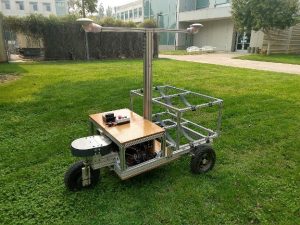The transport robot, which we call the “Grapebot,” was developed under a grant by Sun World International, LLC. It is a three-wheeled electric vehicle designed to carry up to 4 tubs of grapes weighing 25 pounds each. The Grapebot is 68 inches long, 44 inches wide, and weighs approximately 300 pounds. A photograph of the Grapebot is presented in the next Figure.
Short video: Grapebot Video
The Grapebot is powered by a 48 Volt, 50 Amp-hour Lithium-Iron-Phosphate (LiFePo4) battery. Our field tests indicate it can operate up to 16 hours carrying a full load before needing to be recharged. Each of the wheels is a hub motor, that is, a 1 KW motor is built into the hub of the wheel itself. This makes the robot more mechanically efficient and simplifies the control and steering systems. When not powered, the wheel will turn freely, which allows the robot to be driven using one, two, or all three wheels. Tests showed powering the two rear wheels was the most electrically efficient, but it’s good to have the third wheel available to power the robot over obstacles or in particularly rough terrain.
The chassis is constructed primarily using 1.5 by 3 inch extruded aluminum, commonly known as 80/20 beams. As components can be easily bolted anywhere onto 80/20 beams, they offer significant design flexibility over square tube welded chassis. Mounted on the rear of the robot is an aluminum frame with rubber straps to cradle and cushion the tubs of grapes. Though designed to carry 100 pounds of grapes, we have successfully driven the robot with a 300-pound load.
Mounted at the center of the Grapebot is a mast with a GPS antenna. This mast can be manually raised to a height of 8 feet above the ground so the antenna can reach above the canopy if necessary. The robot uses a Real-Time Kinematic (RTK-GPS) system, which receives correction over mobile Internet. Its position can be determined to within a few centimeters. At the front of the Grapebot is the electronics compartment, which houses the battery and all of the electrical, motor control, navigation, and communication hardware. A small onboard Intel NUC computer performs all computation.
A steering motor is mounted near the front wheel, and a sprocket-and-chain mechanism connects that motor to the steering axis of the front wheel. The front wheel can turn plus or minus 90 degrees from the center, which, combined with differential driving of the rear wheels, allows the Grapebot to essentially turn in place (almost zero turning radius). The robot can travel forwards or backward with equal ease, accuracy, and precision. The top speed of the Grapebot is 3 meters/second, though, for safety reasons, we limit the speed through software to 1 m/s, which is normal walking speed. If given a digital map of the vineyard, the Grapebot can navigate autonomously. It can also be manually driven using an X-box controller. There is a large emergency stop button mounted on top of the electronics compartment. When pushed, all power to the robot is immediately terminated.
A significant amount of software allows the Grapebot to operate autonomously in conjunction with instrumented picking carts. Obviously, the system requires knowing the precise locations of the robot, the carts, and the central collection station at all times. A digitized map of the vineyard is necessary to compute the route taken by the Grapebot as it travels to and from a picking cart. Additional software optimizes the strategy for one robot to serve multiple pickers. A large part of the software had been developed in the context of a prior project for robotic strawberry harvest aids, under USDA-NIFA funding.






